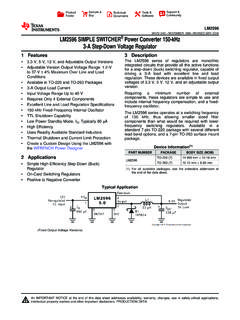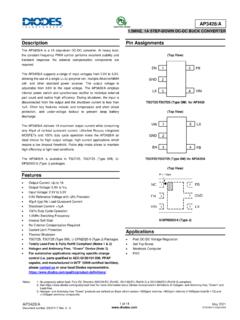Transcription of Efficiency of synchronous versus nonsynchronous buck ...
1 Texas Instruments Incorporated Power Management Efficiency of synchronous versus nonsynchronous buck converters By Rich Nowakowski, Power Management Product Marketing and Ning Tang, Systems Engineer, SWIFT DC/DC Converters Choosing the right DC/DC converter for an application can Figure 1. synchronous and nonsynchronous be a daunting challenge. Not only are there many available buck circuits on the market, the designer has a myriad of trade-offs to consider. Typical power-supply issues are size, Efficiency , cost, temperature, accuracy, and transient response. The VIN. need to meet ENERGY STAR specifications or green- mode criteria has made energy Efficiency a growing Q1. concern. Designers want to improve Efficiency without Control Switch Node increasing cost, especially in a high-volume consumer L1.
2 Electronics application where reducing power consump- VOUT. tion by one watt can save megawatts from the grid. The semiconductor industry has recently developed low-cost Q2 D1. Control C1. DC/DC converters that employ synchronous rectification and that are thought to be more efficient than nonsyn- chronous DC/DC converters. This article will compare the Q2 integrated with Efficiency , size, and cost trade-offs of synchronous and synchronous converter nonsynchronous converters used in consumer electronics under various operating conditions. It will be shown that synchronous buck converters are not always more efficient. Typical application a low-side MOSFET (Q2) is used. In a nonsynchronous - To demonstrate the subtle differences between the two buck topology, a power diode (D1) is used.
3 In a synchro- converter topologies, a typical point-of-load application was nous converter , such as the TPS54325, the low-side power chosen. Many low-cost consumer applications use a 12-V MOSFET is integrated into the device. The main advantage rail that accepts power from an unregulated wall adapter of a synchronous rectifier is that the voltage drop across or an off-line power supply. Output voltages usually range the low-side MOSFET can be lower than the voltage drop from 1 to V, with output currents under 3 A. The Texas across the power diode of the nonsynchronous converter . Instruments devices in Table 1 were chosen to compare If there is no change in current level, a lower voltage drop actual Efficiency measurements under various output- translates into less power dissipation and higher Efficiency .
4 Current and output-voltage conditions. The rated output current, which is the level of output current each device Choosing the power diode is marketed to deliver, was taken directly from the data nonsynchronous converters are designed to operate with sheets (see References 1 and 2). an external power diode (D1). The three key specifications a designer needs to consider when choosing a power diode are the reverse voltage, the forward voltage drop, and the Table 1. Device comparison forward current. First, the rated reverse voltage must be INPUT at least 2 V higher than the maximum voltage at the switch PART RATED IOUT. TOPOLOGY VOLTAGE RANGE. NUMBER (A) node. Second, the forward voltage drop should be small for (V).
5 Higher Efficiency . Third, the peak-current rating must be TPS54325 synchronous buck to 18 3 greater than the maximum output current plus one-half the TPS54331 nonsynchronous buck to 28 3 peak-to-peak inductor current. When the duty cycle is low ( , at low output voltages), D1 operates as a catch diode that conducts more current than the high-side MOSFET. Basic operation A fourth consideration is to make sure the package of the A typical block diagram for a step - down (buck) regulator is diode chosen can handle the power dissipation. The diode shown in Figure 1. The main components are Q1, which is chosen for the TPS54331 was the B340A, which has a the high-side power MOSFET; L1, the power inductor; and reverse voltage rating of 40 V, a forward voltage drop of C1, the output capacitor.
6 For a synchronous -buck topology, V, and a forward current rating of 3 A. 15. Analog Applications Journal 4Q 2009 High-Performance Analog Products Power Management Texas Instruments Incorporated The TPS54325 does not need a power diode, since a 70-mW low-side MOSFET is integrated into the chip. The integrated MOSFET saves space; but the complexity of the control circuitry must be increased to ensure that both MOSFETs do not conduct simultaneously, which would result in a direct path from the input to ground. Any cross conduction would result in lower Efficiency and could even overload and damage the system. Efficiency calculations To calculate the Efficiency of a DC/DC converter , the total power dissipation needs to be computed.
7 The key contributors to the power dissipation for a DC/DC converter in continuous conduction mode (CCM) are the high- and low-side switching losses and the IC's quiescent-current loss. The formulas for these losses are as follows: 2 VOUT. PConduction _ HS = IOUT R DS(on ) (1). VIN. PSW = VIN VOUT ( t Rise + tFall ) fSW (2). PQuiescent = VIN Iq (3). Equations 1 through 3 apply to both the synchronous and the nonsynchronous converter in CCM. However, the losses in the low-side MOSFET for the synchronous buck converter (Equation 4) and in the low-side power diode (PD1) for the non- synchronous buck converter (Equation 5) need to be included: 2 VOUT . PConduction _ LS = IOUT R DS(on ) 1 + ( 2 t Delay fSW IOUT VFwd ) (4).
8 VIN . Low-Side MOSFET Body Diode V . PD1 = VD1 _ Fwd IOUT 1 OUT (5). VIN . In Equation 4, the first component represents the con- reduced to improve thermal performance so that a less duction loss in the low-side MOSFET, and the second com costly package can be chosen to house the smaller power ponent represents the conduction loss in the body diode. MOSFET with a higher drain-to-source resistance. The current flowing through the body diode is about an order of magnitude lower than the current flowing through Efficiency results at high loads the low-side MOSFET and is negligible at 2 A. Two circuits were built with the devices shown in Table 2. These equations make it evident that there are several so that the efficiencies of the circuits could be compared.
9 Factors influencing full-load Efficiency , such as the drain- The devices used the same LC filter in the bill of materials. to-source resistance, drain-to-source forward voltage, duty Even though the two devices had slightly different fixed cycle, frequency, and power MOSFET rise and fall times. switching frequencies, there was not enough impact on The AC and DC losses of the inductor and the equivalent cir cuit Efficiency to alter the conclusion of this demon . series resistance of the output capacitance are similar in stra tion. An input voltage of 12 V was chosen, and effi- the application, since the same LC filter can be used for ciency measurements were taken by simply varying the both devices.
10 For a DC/DC converter , the duty cycle is output voltages. given, and only the drain-to-source resistance, forward voltage drop, and switching frequency can be chosen. Table 2. Basic device characteristics Typically, the MOSFET rise and fall times are not stated in PART HIGH-SIDE RDS(on) LOW-SIDE RDS(on) FREQUENCY. the data sheet but are important specifications to consider, NUMBER (mW) (mW) (kHz). since the faster they are, the less power is dissipated. The TPS54325 120 70 700. trade-off is noisy ringing at the switch node when a power N/A. MOSFET is turned on too quickly. Start-up time can be TPS54331 80 570. (VD1_Fwd = V). 16. High-Performance Analog Products 4Q 2009 Analog Applications Journal Texas Instruments Incorporated Power Management Figure 2 shows the Efficiency of both devices with a of the TPS54331 improved dramatically.















